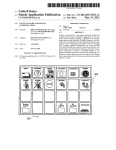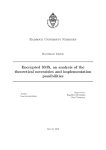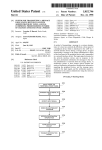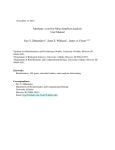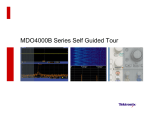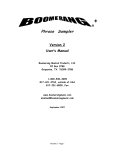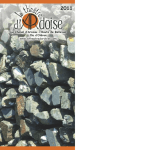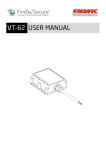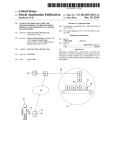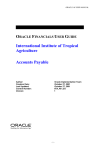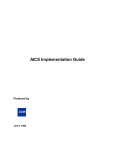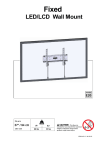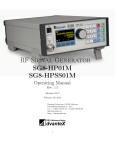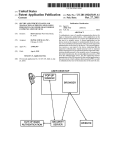Download ||Il|lIIIIIIIIIIIIIIIIllIlIllIlIlIlIll||||lIlllIlIlIIIllIlIllIIIlllIlIIIlll
Transcript
||Il|lIIIIIIIIIIIIIIIIllIlIllIlIlIlIll||||lIlllIlIlIIIllIlIllIIIlllIlIIIlll US005504315A United States Patent [191 [11] Patent Number: Hardesty et al. [45] Date of Patent: [54] 5,504,315 * Apr. 2, 1996 IVIEANS AND METHOD FOR NON-CONTACT 4,795,281 1/1989 Ulinksi et al. ........................ .. 235/432 BAR CODE LABEL VERIFICATION 4,860,226 8/1989 Martin et al. 4,894,790 1/1990 Yotsuya et al. .. [75] Inventors: John Hardesty, Ervine, Calif.; Edward _ . I}; . , lslxgalslgglgfugays'ggrgég?lrd _ _ _ _ ’ ,' " _ ’ Mission VICJO; Timothy Almeida, Santa zyyowicze 5,194,720 311993 Reinnagel et a1. 5,218,190 6/1993 Hardesty et al. .. . ..... .. 235/437 ..................... .. 235/462 FOREIGN PATENT DOCUMENTS [73] Assignee: Symbol Technologies, Inc., Bohemia, 55‘88172 7,1980 Japan ' OTHER PUBLICATIONS N -Y- [*l Notice; IIXIIOYHEWT ---- , Ana, both of Calif. 364/552 ..... .. 364/552 The ponion of the term of this patent subsequent to Jun. 8, 2010, has been disclajmed, “Quick Check 500” brochure, Photographic Sciences, 2 Pages (1939) Barkan, Automatic I.D. News, “Author veri?es the key to bar coding success”, (Nov. 1988). [21] Appl- N04 59,252 [22] Filed, Primary Examiner—Robert A. Weinhardt May 7 1993 ' Attorney, Agent, or Firm-—James H. Beusse 9 _ ' [57] Related U.S. Apphcation Data ABSTRACT A portable, conveniently usable, and inexpensive non-con [63] Continuation of Ser. No. 592,021, Sep. 28, 1990, Pat. No. tact bar code veri?er permits testing of bar code labels at some arbitrary but constant distance from the veri?er. Means am provided for analog analysis of bar code label contrast levels, and for derivation of new, instructive indices char 5,213,190- [51] Int. Cl.6 ..................................................... .. G06K 7/10 S Cl 235/462 235/437 [52] U F: I'd """ """""""""""""""" " 23 5,262 472 [58] ‘e 0 acterizing the readability and print quality. Additionally, a 932635436 43,7’ 438: ’ ’ 564/5171 04 552’ 563’ ‘ ’ new method for determination of absolute bar code label dimensions is disclosed. The method of calibration for ’ arbitrary scanning distance and angle standardizes not only the veri?er’s ability to measure absolute dimensions at . [56] References Clted unknown distances, but also its ability to discern contrast U.S. PATENT DOCUMENTS 4 199 8 6 4,1 4’251’7;8 0 2,1321 4’360’798 under arbitrary lighting conditions and scanning equipment. h 4,5 1 04 This is accomplished by employing calibration standards of :yal """""""""""" " 36 11,1982 swam et al' ‘ ________ . ‘ I ''- _ I II I i -. 7 ' known characteristics. Bar code veri?cation information 235/463 may be stored and/or employed for a variety of control and 235/462 analytical functions as recognized in the HIT. 1,1983 swam et 4,508,686 4/1985 Shaber et al. . .... .. 235/466 4,705,939 11/1987 Ulinski . . . . . . . . . . . . . . .. 364/563 9 Claims, 10 Drawing Sheets I I I I I I AUTO VERIFY REVIEW DATA OPTIONS CALIBRATE DECODE omsuosncs USER LD. 505 SIG 520 -_ CODABAR mouISTRY c129 I I I - UPC/EAN/JAN 3| 530 ' ISYMBOLOGYH GROUP Hcwcxl IREPORTSHOUTPUTI _ UPDATE . C93 . 525 - DELETE CODABAR ' . . IiTA - C128 ' I25 . C39 ' VERIFIER _ D25 . C93 ' UPC/ EAN/ JAN PR'NTER MEMORY ‘ RS-232 ' MSI SERIAL PORT - IATA I 52255 - BASIC REPORT ' ELEMENT REPORT . ANS“ _ _ ?g“ ' ' AIAG VICS ' ' EMBARC IATA - MEASUREMENTS ' DEVIATIONS - NOMINAL REPORT - INDUSTRY REPORT US. Patent Apr. 2, 1996 110 Sheet 1 of '10 5,504,315 105 / CA‘ Hail .I-U'HI' 115 @ E B wm m@ m____ __n___ ENTER @EWQB :3. 0o FIG.1 U.S. Pater‘lt Apr. 2, 1996 Sheet 2 of 10 5,504,315 é/ aaa 08Nd: ‘lzYmvia. US. Patent Apr. 2, 1996 FIG“ Sheet 3 of 10 I 5,504,315 BARCODELABEL FIG. 3C LWWDIGHAL SIGNAL 0 n . . Q - . . - . . - . - . - I I - . . I . . . . . Q . v n . - 1 - u v ’ n u u - u - n Q u u a . I ‘ - . I I u n u u ¢ u a u . - ¢ ¢ Q I o . TIMED TRANSITION INTERVAL FIG. 3E I I I I I I I l I BARCODELABEL PM’ KW RAW REFLECTIVITY F's-3G I...Ji....d|UL...JIIIIMJLJHMHIWJIIn]LJHIU i'?ilgiqm US. Patent Apr. 2, 1996 Sheet 4 of 10 420 m _@@Emm_ @ m_@ h____ ___._. ENTER FIG.4A 7N @m_ @m_wtEQU / __ :3 5,504,315 US. Patent Apr. 2, 1996 Sheet 5 of 10 r’ SELECT SYMBOLOGY w » CQDABAR 5,504,315 T T DECODE DIAGNOSTICS MSI CODE 11 INTERLEAVED 2 OF5 DISCRETE 2 OF 5 CODE 39 SCAN CODE 3 (F9 TO BE ANALYZED L EAN/JAN 8 L F l G. 8A a F l G. 88 CODE 3 OF 9 CODE 3 OF 9 *01234567* [3 N E] 4 E] EH3 A CHARACTER: UNKNOWN CHARACTER: START STATUS! GOOD PRESS<H> FOR HELP STATUS: BAD ILLEGAL BIT PATTERN PRESS<H> FOR HELP F I G. 8C F l G. 80 SCAN MODULE Q5 CONNECTOR “115 CPU ,uEM 9&6 522 FIG.4B U.S. Patel‘lt Apr. 2, 1996 Sheet 7 of 10 PIIIuIII 5,504,315 I III IIIII IIII III“ I... .III.I..I.IIII...I- IIIuIIII'IIIIIIIIIIII IIIIIIIIIIIIIIII IIIIIIIIIII I IIIIIII.I.I.I.I IIIIIIII.II IIIIIIIIIIIIIII...II JIIIIIIIIIII I\ IIIIII.IIIIIIII.I IIIIIIII I I IIIIIIIIIII IIIIIIIII IIIIIII IIII IIIII IIIIuII~I IIIIIIIIIIIII IIII-.I.II.“"I. IIII) InII IIIIIIIIII IIIII IIII IIIIIIIIIIII III II IIIII II II IIIIIII IIIII IIII III I III .. I III IIII II Ir II I II I.II.II II IIIIIII IIIIIII III“II-nIII I II II II III III IIIII III‘IIIII IIII.IIIIIIIIIII I II“ III II I II I IIII II IIII IIIIIII I"I IIIIIIIIII III II IIIIIIII\I ...I.. I41.I11.I‘.II.‘ IIIIIIIIIIII I--uhIIII I II III III II I m<w.do_I U.S. Patent Apr. 2, 1996 5,504,315 Sheet 8 of 10 ANALYSIS SCREEN 1 1 10/11/89 1038 AM ’ ANALYSIS SCREEN 2 T BAR WIDTH RATIO= 2.9a Code 3 of 9 GROWTHILOSS= +OO.16 STI GRADE LMARGIN RATIO GOOD RMARGIN RATIO GOOD PERCENT DECODE 100% CONTRAST: 67% 93% A PRESS <H> FOR HELP J PRESS <H> FOR HELP J L F 1 6.78 1 ANALYSIS SCREEN 3A 1 ELEMENT REPORT MIN AVG MAX WBAR- 3O 31 32 NBAR- 11 12 14 WSPC- 29 32 33 T ANALYSISSCREEN 38 S ELEMENT REPORT MOD MIN AVG MAX RAT 1 12 14 16 2 26 28 302.00 3 4O 42 44 3.00 4 54 54 54 3.88 PRESS<H> FOR HELP NSPC- 1o 12 14 PRESS <H> FOR HELP ; 2 L ANALYSIS SCREEN 4 MEASUREMENTS *STI 3 OF 4 * BAR 12 27 41 \2 SPC BAR SPC 15 12 43 15 12 15 15 PRESS <H>FOR HELPJ ( J i ANALYSIS SCREEN 5 DEVIATIONS *STI3OF4* BAR SPC BAR SPC -2 0 0 +1 0 +1 -2 +1 +1 +1 PRESS<H> FOR HELP) FIG. 7F US. Patent Apr. 2, 1996 Sheet 9 of 10 5,504,315 FIG.9 200 US. Patent Apr. 2, 1996 Sheet 10 of 10 5,504,315 'sweep 2d FIGJOB 5,504,315 1 2 lVIEANS AND METHOD FOR NON-CONTACT BAR CODE LABEL VERIFICATION tioning subsystems: a bar code printing system and a bar code reading system. It is the shortcomings in either or both This is a continuation of application Ser. No. 07/592,021, ?led Sep. 28, 1990, now US. Pat. No. 5,218,190. code veri?cation system. Among the problems occurring as a result of faulty of these two subsystems that often necessitate a third, a bar LA printing systems are insuf?cient contrast between bars and spaces (collectively referred to in the art as “elements”) of TABLE OF CONTENTS BACKGROUND OF THE INVENTION 1.1 Field of the Invention 1.2 Description of Prior Art 2. SUMMARY OF THE INVENTION 3. BRIEF DESCRIPTION OF THE DRAWINGS 4. DETAILED DESCRIPTION OF SPECIFIC EMBODI~ MENTS a bar code label, unintentional bar width growth or loss due to ink spread or shrinkage, ink voids or specs or other 10 printing errors. Bar code reading systems fail due to hard ware problems such as maladjusted or ineffective sensors, emitters, or processors in reading apparatus, and, in addition, 15 4.1 Overview of Veri?er Operation 4.2 Functional Description 4.2.1 CALIBRATE 4.2.2 AUTO VERIFY 4.2.3 DECODE DIAGNOSTICS 4.2.4 REVIEW DATA 4.2.5 OPTIONS 4.2.6 USER ID 4.3 Hardware Setup 4.3.1 Scanning Module tively identify existing or potential problems in the printing 20 mance potential. For example, bar code printers might use a designed to monitor print quality trends during the printing 25 30 of speci?cation. Alternatively, downstream bar code system users, warehouse inventory managers, for example, might products, or to note bar code labels that will require special handling as they move through the system. An article by one of the present inventors on the subject of bar code veri?ca tion is instructive in pointing out potential bar code prob lems, and potential veri?cation solutions. See “Opinion” by 35 Tina Barkan at: “Automatic I.D. News,” November 1988. Previously, two types of veri?ers, both requiring contact of the scanner with the bar code label, have been employed. The ?rst, a contact-wand, uses a light emitting source at the end of a pencil-looking wand which is guided manually over 4.4.4 Re?ectance Compensation for High-Density Labels 5. CONCLUSION WHAT IS CLAIMED IS: ABSTRACT process and stop printing as bar codes begin to be printed out use information derived from a bar code veri?er to alert him/her to the need to print new labels for a group of 4.3.3(c) Analog Circuitry 4.4.1 Calibration 4.4.2 Software Generated Indices and Information 4.4.3 AUTO VERIFY Method and reading systems, thus allowing the user to adjust the bar code system to derive its maximum e?iciency and perfor veri?cation program as part of a quality control scheme 4.3.3(a) Microprocessor 4.3.3(b) Memory 4.3.3(f) Other 4.4 Software Setup programming of the processor in the reading apparatus. For these reasons, those who employ bar code systems often have need for a veri?cation system which will effec 4.3.2 Electrical Interface Cable 4.3.3 Processor unit 4.3.3(c) Gate Array 4.3.3(d) Communications due to user mistakes such as improper positioning of the scanner relative to the bar code label of interest or improper 40 the bar code label by the user. Light emitted from the light source is re?ected by the bar code label pattern and received by a detector also in the wand. This type of veri?er requires a single pass of the wand over the bar code label to check the label and acquire the appropriate information. A second type I. BACKGROUND OF THE INVENTION 45 1.1 Field of the Invention In inventory-intensive wholesale and retail operations, bar coding systems have become popularly employed in track ing the ?ow of products. Bar coding systems frequently include not only printing and reading equipment, but also 50 means for veri?cation. Veri?cation is a process by which a Plessey, etc.) and industry group (e.g., ANSI, LOGMARS, The known optical scanning veri?er systems have not > proven to be altogether satisfactory for a variety of reasons. First, contact-type veri?ers are inconvenient. Furthermore, by virtue of the fact that they am designed to block out ambient lighting conditions, contact-type veri?ers are not bar code label is analyzed to determine if it has been printed in accordance with print speci?cations dictated by the par ticular bar code symbology (e.g., UPC, Code 39, MSI/ of prior art veri?er is the laser-based veri?er which also requires contact between the head of the scanner unit and the bar code label. However, the laser-based veri?er checks the bar code label multiple times as the laser beam sweeps rapidly back and forth across the label. 55 IATA, etc.) against which it was printed. The present invention relates generally to optical scanning systems for use in bar coding systems. More particularly, the accurately predictive of bar code readability under various reading conditions a?ecting noncontact~type readers. Sec ond, analysis of quality and readability of bar code labels in prior art veri?ers has not been as descriptive and instructive as often desired. Third, prior art veri?ers have not had the present invention relates to portable, non-contact bar code 60 added capability of being usable as bar code readers. Fourth, veri?er arrangements and method by which the quality and prior-an laser-based veri?ers have generally not been con readability of scanned bar code labels are measured, ana veniently portable due to their large size. Fifth, prior-art lyzed, and reported in a convenient and inexpensive way. veri?ers have been expensive due to their large number of 1.2 Description of Prior Art The advantages of bar coding systems are well~known. In order for a bar code system to e?‘ectively handle inventory information, it must comprise at least two properly func components required for signal processing. Finally, due to 65 the use of separate technology for veri?cation and reading, bar code veri?ers have not been accurately predictive of a reader’s ability to read a particular bar code label. 5,504,315 3 4 2. SUMMARY OF THE INVENTION When a target label is subsequently scanned for veri?ca tion, a map of perceived widths of a target label is likewise The present invention overcomes some of the drawbacks generated; the veri?cation scanning is performed under of the prior art. A portable, conveniently usable, relatively ambient conditions similar to the calibration-pattern scan and at the same standard distance. Applying the previously computed correction factors to the information represented inexpensive non-contact bar code veri?er is provided which will test bar code labels removed some arbitrary, but con stant distance from the veri?er. The bar code veri?er can in the map results in a more accurate representation of the calibrate its operation according to the distance by which it is removed from the bar code label being analyzed. The calibration approach helps compensate for variations in, e. g., target label. provided for analysis of print contrast quality in bar code known to the veri?er software. By scanning both calibration labels. Additionally, a bar coder veri?er is provided that can also standard labels, the veri?er creates a contrast scale against which contrast levels derived in the normal operation of the veri?er are compared. Once calibration has been performed for a speci?c scanner module orientation (distance and angle) relative to the bar code label of interest, the veri?er In one embodiment, the veri?er calibrates itself for arbi the motor speed of the veri?er scanner subsystem and other 10 trary, but constant lighting conditions affecting its operation. veri?er characteristics. The two bar code calibration standards used for measure ment calibration are of different contrast levels—both levels Further, according to the present invention, means are function as a bar code reader. Also, according to the present invention, means are pro vided for verifying a bar code label using a wavelength of light and scanning technology similar to those that will is ready for operation in its normal mode. Alternatively, of subsequently be used by reading apparatus. course, a single calibration standard may be used. Additionally, means are provided for determining the absolute dimensions of bar code label elements. The present invention includes bar code label veri?er According to another feature of the present invention, methods are provided for identifying and decoding bar code labels and, subsequently, issuing diagnostic reports charac apparatus for use in measuring and analyzing the quality and terizing their readability. A target bar code label scanned by readability of printed bar code labels (“target labels”). The apparatus includes means for acquiring digital and analog the veri?er is classi?ed as a member of a certain symbology information characterizing a bar code label (sometimes referred to herein as “re?ectivity data”), coupled with means three step method: for processing and analyzing that information, and for reporting bar code label readability and print quality indices as derived from the analog and digital information. Visible laser light emitted by veri?er emitter means is (e. g., C39, C93, UPC, etc) by an application of the following 1) Identify the target label’s boundaries by locating its 3O 2) Check the number of transitions (i.e., bar-to- space or space-to-bar), because certain symbologies can have only certain numbers of transitions; and re?ected from a series of “white” (comparatively more re?ective) spaces and “black” (comparatively less-re?ec tive) bars comprising a bar code label, and, subsequently is 3) Attempt a character-by-character decode of the sym 35 veri?er is to assume that the target label of interest belongs to a certain symbology or group of symbologies. According to another feature of the invention, means are series of data corresponding to binary digital re?ectivity levels as measured by said scan means. The data series are derived by the processor. 45 In accordance with the non-contact feature of the present invention, a method is provided by , which the veri?er for an arbitrary, but constant distance and angle of the scanner module (comprising emitter and scan means) rela tive to the bar code label of interest. Calibration is accom plished by scanning one or two calibration standard patterns 55 Calculation of label print contrast index; Characterization of label print quality rating as measured by bar width growth/loss, element absolute widths and width ratios; Calculation of percent decode index, Calculation of margins rating; Calculation of weighted “scannability” index. from scanning a calibration standard pattern under then~ ambient conditions (at an arbitrary standard distance) to determine re?ectivity data corresponding to a plurality of A veri?er processor unit is preferably equipped with output means including a display screen, printer terminal, and a scrim output port. Input means comprising a keyboard points on the calibration standard pattern. The veri?er uses the calibration-standard data to develop a “map” of the perceived widths of the various bars and spaces comprising the calibration standard pattem. These perceived widths can be rendered less than optimally accurate by, e.g., variations in scanner motor speed. The actual widths of the calibration pattem bars and spaces are known, however; this enables the veri?er to compute appropriate correction factors to com pensate for such inaccuracies. provided for analysis of print contrast and quality of bar code labels. Software processing of both analog re?ectivity data and digital re?ectivity data yield a plurality of functions and indices re?ecting print contrast and quality, respectfully. Functions performed and indices produced by the veri?er processor using digital and analog data in normal operation include: Identi?cation of symbology and data content of label; software calibrates its measuring parameters to compensate of known element (bar and space) size and print quality. Notably, the veri?er analyzes the re?ectivity data received bologies passed by step #2. According to another feature of the invention, the veri?er can be limited in the possible symbologies it recognizes and attempts to analyze. That is, a user may specify that the received by veri?er scan means. Raw signal processing means yield a series of data corresponding to analog re?ec tivity levels as measured by said scan means and, other stored in random access memory (RAM) using direct memory access (DMA) operations. From RAM, the data are accessible to the veri?er processor and become the basis for a number of software functions performed and indices margins; are also provided. Processor software functions are menu driven to enable the user to determine the mode of operation of the veri?er. Additional hardware features of the present invention 65 include a scanner gun trainer for standardizing scanner orientation relative to bar code labels of interest; visible laser-based diode emitter means; use of direct memory 5,504,315 5 6 access (DMA) hardware internal to microprocessor to acquire laser scan information (digital and analog); use of Turning now to FIG. 1, a bar code label veri?er 100 constituting one illustrative embodiment of the present custom application modules for switching applications. invention is shown. A scanning module 105 is operatively Additional software features of the present invention attached to a processor unit 110 via an electrical interface include downward application of the veri?er as a bar code cable 115. A trigger 120 functions to initiate a scan operation reader; certain software generated print quality and read by the scanning module 105. Laser light is emitted in a beam ability indices which are new to the art. from an emitting means located behind a scanning window Information derived by the veri?er of the present inven tion may be stored and/or employed in control and analytical functions related to bar code system quality as commonly recognized in the art. These and other features of the invention will become apparent hereinafter. It will be understood that the present invention comprises many separate novel features which can be employed individually or in combination and, can be arranged in various con?gurations or orders to accomplish substantially the same results and objects. Accordingly, any 125. The scanning window 125 and associated components (e.g., laser emitter components and optical components) may be of a design similar to that shown in U.S. Pat. No. 4,897,532, “Portable Laser Diode Scanning Head,” by Swartz et al., issuedlan. 30, 1990. The laser beam sweeps back and forth rapidly in a motion horizontal to the long axis of the rectangular scanning window 125 (shown from the 15 side). FIG. 2 shows generally a bar code label 200. As emitted laser light impinges on a remotely located bar code label 200, it is re?ected to varying degrees by the bars 205 description of arrangements of equipment and methods given in the following or preceding explanation should be and spaces 210 comprising the bar code label 200. Re?ected An example of a veri?er employing features of the present invention in one exemplary embodiment, is the Laser Chek to the intensity of radiation impringing upon it. light is detected by a radiation sensitive scan means also understood to be illustrative and exemplary in nature, and is 20 located behind scanning window 125. Said scan means not intended to be self-limiting in any manner whatsoever. functions to produce an analog electrical signal proportional In order to calibrate veri?er operation for the unknown distance and angle of the emitting means and scan means 25 relative to the subject bar code labels, a calibration routine H is included as Appendix D in the parent application, which is executed which entails the user scanning two calibration H by Symbol Technologies, Inc. As an aid to understanding the present invention, the User Manual for the Laser Chek issued as U.S. Pat. No. 5,218,190 (hereby incorporated by standard labels of known characteristics. The perceived reference). Additionally, source code for the Laser Chek II software is included as Appendix E in the parent application, widths and contrast of bars and spaces constituting the calibration standard labels are compared to previously stored which issued as U.S. Pat. No. 5,218,190 (hereby incorpo 30 known widths and contrast in order to derive conversion rated by reference). factors to be used subsequently in relating relative scan data to absolute distances and contrast levels. Three states of operation are provided for veri?er opera tion. A programming state is provided for use in allowing 3. BRIEF DESCRIPTION OF THE DRAWINGS 35 veri?er users to alter and customize veri?er operational FIG. 1 shows in general an exemplary speci?c embodi parameters. A calibration state is provided by which users ment of the present invention. will calibrate the veri?er for the arbitrary, but constant FIG. 2 shows an enlarged view of a bar code label. conditions under which it will verify bar code labels in normal operation state. Finally, a normal operation state is FIGS. 3A-3G show the effects of signal processing on the provided for scanning bar code labels of interest. In normal operation, ?ight re?ected from a subject label raw re?ectivity signal derived by veri?er sensing means. FIG. 4A shows generally an exemplary speci?c embodi ment of the present invention as arranged during operation; FIG. 4B is a block diagram of certain components of the embodiment. FIG. 5 shows an exemplary menu structure for the veri?er of the present invention. FIGS. 6A & 6B illustrate generally the appearance of black and gray calibration standards. 200 is sensed by scan means located in scanning module 105, behind scanning window 125. Conventional signal 45 processing occurs locally to the scanning module 105 and in the unit 110, and results in twenty-eight series of data points, each series corresponding to a binary digital representation of the light re?ected from the bar code label during one emitting means sweep. FIG. 3A illustrates the step-by-step eifect of processing on the raw re?ectivity signal derived FIGS. 7A-7F show exemplary analysis report screens 50 from scan means. An analog-to—digital converter located in used to report various information derived by a veri?er operating in so-called AUTO VERIFY mode. the scanning module converts the analog signal into a binary FIGS. 8A-D show exemplary analysis report screens used to report various information derived by a veri?er operating in so-called DECODE DIAGNOSTICS mode. signal is converted to a time-based count of relative per signal Subsequently, in the unit 110, that binary digital FIG. 9 shows the orientation of the laser scan beam ceived transition widths. That is, a clocking digitizer creates discrete data points corresponding to the perceived time spacing between re?ectivity level transitions. Only a repre emitted by the veri?er relative to the bar code label of interest in normal operation. sentative number of points are shown in FIG. 3A for illustration. It will be understood that one data point will be 55 created by the clocking digitizer for each transition per FIG. 10 shows differing possible placements of the veri ceived. It will further be appreciated that the series of data labeled “Time Transition Intervals” is representative of the relative distance between re?ectivity level transitions detected by scan means. These data are placed in random access memory (RAM) storage by direct memory access ?er scanning means relative to the label of interest which are illustrative of the need for calibration. 4. DETAILED DESCRIPTION OF SPECIFIC EMBODIMENTS. 4.1 Overview of Veri?er Operation 65 (DMA) operations. Immediately thereafter, the scanning module 125 acquires another series of data, this series corresponding to analog re?ectivity levels detected by the 5,504,315 7 8 scan means during one emitting means sweep. FIG. 3B 505, the veri?er functions to set the maximum/minimum illustrates this step-by-step eifect of signal processing on the raw re?ectivity signal derived from scan means. A digitizer contrast limits and adjust the veri?er measuring parameters for a given scanning module 105 orientation (distance and creates discrete data points corresponding to the analog re?ectivity levels perceived by the scan means and further angle) relative to the bar code label 200 of interest. AUTO VERIFY mode 515 and DECODE DIAGNOSTICS mode ampli?ed by a differential ampli?er. The digitizer and the differential ampli?er circuitry are disclosed further in the section “Hardware Setup”. It will be appreciated that the 510 are used to scan bar code labels of interest and, subsequently generate information characterizing them. In series of data labeled “Digitized Analog Signal” is repre sentative of the re?ectivity level detected by scan means. 10 Again, this series of data is transferred into RAM in the processor unit via DMA operations, as disclosed hereinafter. DECODE DIAGNOSTICS mode 510 is used to derive similar information when the user already knows the sym bology of the bar code label of interest. In REVIEW DATA mode 520, the veri?er is functional to review saved analysis With all 29 sets of data in place RAM, the scanning operation is complete. A processor like a Hitachi HD64180 in the processor unit 110 accesses the data in RAM storage as needed in the sessions performed under AUTO VERIFY mode 515. OPTIONS mode 525 functions to allow the veri?er user to software performance of functions and calculation of indices to be speci?ed hereinafter. It will be appreciated that the Hitachi HD64180 is also equipped to execute the DMA transfers of scan data into RAM. select certain veri?er features of diagnostic considerations and actual contents of the diagnostic reports. USER ID mode 20 530 allows the user to select, create, or delete speci?c user identi?cation codes. 4.2.1 CALIBRATE According to the non-contact feature of the present inven Subsequent processing of the analog and digital data sets decodes and identi?es the scanned bar code label and yields a plurality of indices characterizing its readability and print quality. 4.2 Functional Description AUTO VERIFY mode 515, the veri?er automatically dis criminates between symbologies currently enabled for searching and issues a diagnostic report on the type, content, readability and print quality of the scanned bar code label tion, bar code label 200 may be scanned by the scanning 25 In operation, a bar code veri?er 100 according to the present invention functions as described hereinafter. FIG. 4A shows the bar code veri?er 100 as connected and module 105 removed some arbitrary, but constant distance and oriented at some unknown, but constant, angle relative to the label 200. Calibration of the veri?er for the arbitrary conditions is accomplished by means of a calibration routine situated during normal operation. The processor unit 110, in which one or more calibration standard bar code labels of interface cable 115, and scanning module 105 are function known element (bar and space) dimensions and spacing and ally connected. The scanning module 105 is preferably print contrast is scanned. In order to ensure the accuracy of bar code diagnostics reporting, the user calibrates the veri?er before its ?rst use, and subsequently re-calibrates whenever the veri?er orien tation (distance and angle) relative to bar code labels of interest is changed. In one embodiment, when CALIBRATE hand-held by the user and means are provided for attaching the processor unit 110 to the user’s belt for portability and convenience in use. The trigger 120 is activated by the user and serves to initiate a scan operation once the scanning 35 module 105 has been properly positioned above the bar code label 200 of interest. An important feature of the present invention lies in the mode 515 is selected, the veri?er prompts the user to scan ?rst the black calibration standard 600 shown in FIG. 6A followed by the gray calibration standard 605 shown in FIG. 6B. Alternatively, the veri?er control software may be designed so that only a single label is scanned. Once this is ability to make measurements at arbitrary, but constant orientation of veri?er scanner module 105 relative to the bar 40 code label 200 of interest. In order to assist the user in done, the veri?er calibration for that scanning orientation is maintaining constancy of scanner module orientation, a complete. Scan distance and angle must remain relatively plexiglass scanner module trainer 400 is provided. The scanning window end of the scanning module 105 ?ts into constant in subsequent scans performed in AUTO VERIFY a receptacle slot 402 on the trainer 400. The base 404 of the 45 mode 515 or DECODE DIAGNOSTICS mode 510. Scanner module trainer 400 may be employed as one way of ensuring this. Upon repositioning, the scanner must be re-calibrated code label 200 of interest. The trainer 400 provides a for the new scan distance and angle. convenient way of maintaining a particular scanning module Software components of the calibration system will orientation relative to bar code label 200 after the veri?er has become apparent hereinafter. been calibrated for that orientation. As shown in FIGS. 4A and 4B, the portable processor unit 4.2.2 AUTO VERIFY trainer 400 rests on a surface in the same plane as the bar 110 is equipped with a keyboard 405 for receiving user input at appropriate times during veri?er operation; a central A veri?er according to the present invention operating in AUTO VERIFY mode 515 performs diagnostics tests based processing unit (CPU) 406 for performing various control and computation program functions described herein; a memory unit 407 accessible to the CPU 406 for storing program instructions and data (which of course may com prise DRAMs, SRAMs, ROMs, etc., in various combina on re?ectivity information derived from the scan of a 55 particular bar code label of interest. If calibration has not occurred, choosing AUTO VERIFY 505 from the menu leads directly to the unit monitor 410 displaying a prompt message requesting that the user calibrate before diagnostic tions as desired); and a monitor 410 for issuing menu choices and decode reports to the user at appropriate times scanning can occur. during the veri?er operation. A host computer port 415 for AUTO VERIFY mode 505 prompts the user to scan the bar connecting to a host computer and printer port 420 are available for use in the corresponding output modes. In one code label of interest and subsequently presents a diagnostic report based on (a) data derived from that scanning attempt, compared with (b) standard pro?le data, e.g., data coneem embodiment, the processor unit 110 is battery operated. After calibration has occurred, the veri?er operating in In operation, the veri?er is menu driven. FIG. 5 shows the 65 ing element widths, margins, tolerances, number of transi menu structure representing veri?er function choices avail tions, etc., for various bar code label classes (e.g., Code 39, able to the user in one embodiment. In CALIBRATE mode etc.) stored in the memory unit 407. FIGS. 7A-E show the 5,504,315 10 series of screens that would be used to report diagnostic Possible reasons for a DECODE DIAGNOSTICS decode information derived from a bar code label scan. The user failure include: may use the OPTIONS mode 525 choice to customize the information reported as well as the form in which it is No start/stop character; Bad check digit; Margin out of speci?cation; Bad character placement; Minimum Re?ective Difference (contrast) below read reported. It will be apparent from the discussion in subse quent passages how the veri?er processor derives the infor mation reported in the diagnostics report from the digital and analog re?ectivity signals. ability; FIG. 7A shows the processor unit monitor Analysis Screen 1 on which the veri?er reports: The date and time of the analysis; 1O The symbology (code type) of the scanned bar code label; The encoded data content of the scanned bar code label; The scannability trend index (STI), a weighted value of reports available for review by REVIEW DATA mode 520, readability based on fat/thin element measurements, the veri?er internal memory must be enabled through the percent decode, and contrast; ‘and, The American National Standards Institute (ANSI) speci OPTIONS 525 main menu choice as can be seen from FIG. 5. Selecting REVIEW DATA mode 520 from the main menu immediately calls up to the processor unit monitor 410 the ?rst screen of the diagnostic report for the last label scan ?cation grade assigned to the scanned bar code label. FIG. 7B shows processor unit monitor Analysis Screen 2 performed under AUTO VERIFY mode 515. Other diag on which the veri?er reports: nostic report screens may be reuieved by the user by Ratio of wide to narrow label elements (bars and spaces); appropriate input commands issued through the processor unit keyboard. Element growth/loss (deviation from expected widths); Left and right margin status; Percent decode, the number of expected successful decodes of the label in 100 attempts; and, Minimum re?ectance di?erence (contrast). Incorrect number of data characters. 4.2.4 REVIEW DATA A REVIEW DATA mode 520, selected from the veri?er main menu allows the user to review diagnostic reports from previous AUTO VERIFY scans. To make the diagnostic 25 4.2.5 OPTIONS An OPTIONS mode 525, selected from the veri?er main menu, allows the user to customize the operation of the 30 veri?er in regard to the symbologies recognized; the indus try group standards to be applied to the diagnostic analyses; clock operation; form of diagnostics reports; and, selection of diagnostic report output. Symbology: Through this choice, the user may de?ne bar code label of interest as can be seen on the two different which symbology types and variants will be diagnosed by example screens. FIG. 7D shows processor unit monitor Analysis Screen 4 35 the veri?er operating in AUTO VERIFY or DECODE DIAGNOSTICS mode. If the symbology is a variable length code, the user may specify the lengths to be diagnosed. FIG. 7C shows two possible processor unit monitor Analysis Screens 3—labeled 3A and B—on which the veri?er reports wide/narrow element attributes. The contents of this report might vary according to the symbology of the on which the veri?er reports absolute bar/space measure~ ments for each character. Legal symbologies might include, but not be limited to, FIG. 7E shows processor unit monitor Analysis Screen 5 on which the veri?er reports deviations from average for the element widths each character. UPC/EAN/JAN, CODABAR, IATA, I25, D25, C39, C93, C128. For UPC code types, for example, after choosing the symbologies, the user is prompted to choose among the following UPC variants: UPC A, UPC E, EAN 8, BAN 13, SUPP 2, or SUPP 5. Similarly, having selected a multi length symbology, the user is prompted to selectively enable In the event of an unsuccessful decode attempt in AUTO VERIFY mode 515, the veri?er issues diagnostic reports like those in FIGS. 7A-E that indicate failure of the veri?er to read the label- and, as much other information as is possible. or disable the various code lengths available. 45 Industry Group: Through this choice, the user may specify a particular industry group standard which will be applied to the bar code diagnostics analyses performed in AUTO 4.2.3 DECODE DIAGNOSTICS In DECODE DIAGNOSTICS mode 510 a veri?er accord VERIFY or DECODE DIAGNOSTICS mode. Clock: Through this choice, the user may initialize the ered during a scan of a bar code label of known symbology and issues the user a general diagnostics report. After 50 time and date so that diagnostic reports can include time and ing to the present invention analyzes re?ectivity data gath selecting DECODE DIAGNOSTICS mode 510 from the date of testing. veri?er main menu, the user is prompted to select the Reports: Through this choice, the user can customize the form of the diagnostic reports issued by the veri?er operat ing in AUTO VERIFY mode 515. Any of the Analysis symbology of the bar code label of interest and, subse— quently, to scan the bar code label. As before, the veri?er compares scanned data from the bar code label with standard pro?le data for various bar code label classes stored in the memory unit 407. FIG. 8A shows the screen that so prompts the user. FIG. 55 Screens shown in FIGS. 7A-7E can be selectively enabled/ disabled by the user. Output: Through this choice, the user is allowed to select the destination of the diagnostic report output. Available choices include: output port 415, printer port 420, and 8B prompts a scan operation which may be initiated by the internal memory. user. If the bar code label scan is successful, the veri?er will issue a diagnostics report as shown in FIG. 8C. That report 4.2.6 USER ID indicates the code type of the bar code label, the encoded In USER ID mode 530, a veri?er operating according to data content, and a general readability index of the label. the present invention allows the user to select, create, or In the event of an unsuccessful decode attempt, the delete user identi?cation passwords for storing and retriev veri?er may issue a partial diagnostics report as shown in 65 ing individual customized veri?er options selected in a FIG. 8D which delineates as much of the diagnostics data as session. possible and, indicates why the decode attempt failed. 4.3 Hardware Setup 5,504,315 11 12 In one embodiment of the present invention, a bar code the scanning module 105 for the purpose of alerting the user to the completion of a successful decode attempt. 4.3.3 Processor unit Processor unit 110 is preferably a solid state, hand-held, electronic portable terminal for recording, storing and trans label veri?er 100 comprises a scanning module 105 for directing a beam of radiation at a subject bar code 200, and for receiving re?ected radiation representative of the con stituency of the bar code label 200. Veri?er 100 further comprises a processor unit 100, operatively connected to scanning module 105 by means of an electrical interface cable 115. The processor unit 110 may be a solid state, hand-held, electronic portable terminal for recording, stor ing and transmitting ?eld data entered either through the scanning module 105 via the interface cable 115, or from the mitting ?eld data entered either through the scanning mod 10 (voltage regulation) system of integrated chips, and some analog circuitry for treatment of analog re?ectivity data user directly via the keyboard 405. Alternatively, the pro cessor unit 110 and scanning module 105 may be con structed as an integral unit. received from the scanning module 110. A customer replace able 32KB or 64KB EPROM (custom application module) is provided as an additional feature for changing the appli cation program. 4.3.1 Scanning Module The scanning module 105 is preferably a derivative of the publicly available LS-2000 scanner gun manufactured and 4.3.3(a) Microprocessor distributed by Symbol Technologies, Inc., the assignee of this invention; aspects of this scanner gun are described in the aforementioned U.S. Pat. No. 4,897,532, “Portable Laser Diode Scanning Head,” by Swartz et al. A modi?ed scanner board allows scanning module 105 to acquire analog re?ec tivity data and transfer it to the processor unit 110 via 20 closed in the Hitachi HD64180 Data Book (January 1988). 4.3.3(b) Memory it has extra hardware, operates as a regular scanner as well. 25 In one embodiment, memory of three sorts is employed by the veri?er of the present invention. See Appendix C, included in the parent application, which issued as U.S. Pat. No. 5,218,190 (hereby incorporated by reference), for an processor unit 110 and visa versa. In one embodiment, the cable transmits the following signals: digital bar pattern; Microprocessor is preferably of a type like the Hitachi 64180. This device is a Z-80 code compatible eight bit microprocessor with an on-board memory management unit, two UART’s, two sixteen bit timers, an interrupt controller, direct memory access circuitry, and other features as dis interface cable 115. So, the scanning module 105, although 4.3.2 Electrical Interface Cable Interface cable 115 is a standard l0-pin cable assembly used to conduct signals from the scanner module 105 to the ule 105 via the interface cable 115, or from the user directly via the a keyboard 405. Processor unit 110 is provided with a microprocessor, random access memory, a gate array for implementation of all terminal logic, a power management 30 address map. Read only memory (ROM), in the form of a 64KB run time system (RTS) erasable programmable read only analog VIDEO; memory (EPROM), is used to store the run time terminal “start of scan edge”; operation program. trigger; decode LED; laser beam enable; power supply; and A 32KB or 64KB customer replaceable EPROM, also known as a custom application module (CAM), is provided 35 for application programs. The veri?er application resides in the CAM. The run time system EPROM will determine which size CAM is inserted and make appropriate arrange ments. ground. The ‘digital bar pattern’ signal constitutes the digital 40 The CAM is preferably accessible to the user, for characterizes the relative spatial relationships between bars example, under a battery compartment cover. Notably, by replacing the CAM with a suitably programmed CAM in the and spaces comprising the bar code label of interest 200. As explained previously, this signal is timed in the terminal to bar code reader, thus getting “double duty” out of the veri?er re?ectivity data derived from the scan means. The signal determine relative temporal relationships between bars and conventional manner, the user may operate the veri?er as a 45 apparatus. spaces, which relationships can later be converted to abso The veri?er of the present invention uses CMOS static lute spatial relationships using data acquired during calibra random access memory (RAM) chips. A veri?er might be equipped with, for example, 128KB or 256KB RAM depending on the number of populated RAM chip sites. tion. The ‘analog VIDEO’ signal is the analog re?ectivity signal exactly as it comes from the scan means. Terminal 50 under “Analog Circuitry”. the present invention is more conveniently portable, and less expensive than prior art veri?ers. In large part, these advan The ‘start of scan edge’ signal originates in the scanning module 105 and is used to mark the start of a left-to-right or right-to-left laser beam sweep. This signal is vital to proper 55 terminal interpretation of the digital and analog re?ectivity data coming from the scanning module 105. The ‘trigger’ signal is used by the scanning module 105 array handles osm of the I/O functions including LCD select, real time clock, keyscan, write protection, interrupts, laser DMA and output latches for some communications and 60 RS~232 signals. The gate array also generates the I/O select signals 'for controlling latches and tri-state buffers located external to the device. In addition, the gate array generates the run time system (RTS) and Custom Application Module (CAM) EPROM for a bar code label scan in response to depression of the trigger 120 by the user. The ‘decode LED’ signal originates in the processor unit 110 and is used to control a light emitting diode (LED) on tages are related to the use of a custom gate array to handle most of the terminal control functions. That custom gate to signal the processor unit to turn ‘ON’ the laser beam in response to depression of the trigger 120 by the user. The ‘laser beam enable’ signal originates in the processor unit 110 in response to the receipt of the ‘trigger’ signal from the scanning module 105. This signal enables the laser beam 4.3.3(c) Gate Array. According to one stated advantage of the present inven tion over the prior art, a bar code label veri?er according to processing of the ‘analog VIDEO’ signal is described below 65 enable signals, as well as RAM select signals for the various RAM memory devices. 4.3.3(d) Communications 5,504,315’ 13 14 An RS-232 board is provided for communication between the processor unit 110 and a host computer. The RS-232 board contains the necessary voltage convertors and drivers for true RS~232 level signals. An external serial interface device (ESID) connector is A veri?er according to the present invention includes software means for the implementation of a plurality of functions related to calibration, to label identi?cation or to analysis of readability and print quality. 5 provided to accommodate use of any one of a plurality of existing contact or non-contact scanners, including the LS-2000 laser scanner that is part of the LaserChek II invention,‘ the orientation of the veri?er scanning module 105 relative to the bar code label 200 of interest is assumed to be unknown. Part of the software function of the proces (Symbol Technologies, Inc.) bar code veri?er designed according to this invention. Data output to this interface is output through a UART located in the 64180 microproces_ sor. Signals are provided which allow the terminal software to determine which peripheral device is attached to the prot and so adjust its response accordingly. Data input from the peripheral to the interface is directed to an I/O controller, and to the UART in the microprocessor. Data input from a wand or scanner will be input through the I/O controller; ASCII data from any other peripheral device may be input into the built-in UART in the microprocessor. The analog re?ectivity signal derived in the scanner module 105 is not handled by the ESID interface. It is sor is to calibrate the measurement scheme of the veri?er for a particular scan distance and angle. Two challenges are introduced by the non-contact feature of the veri?er: (1) “teaching” the veri?er to measure dis tances (widths of bar code elements, etc.) at an arbitrary, but 15 constant scanning distance and angle and, (2) “teaching” the veri?er how to measure contrast at an arbitrary, but constant scanning distance and angle. The former problem-how to measure distances——relates to the fact that the veri?er sensor measures re?ectivity versus time as opposed to re?ectivity versus distance. The emitter means produces a scan beam across the bar code label. This scan beam 900 is illustrated in FIG. 9 in relation handled instead by analog circuitry in the terminal as described below. 4.3.3(e) Analog Circuitry According to one feature of the present invention, means 4.4.1 Calibration. In accordance with the non-contact feature of the present 25 are provided for measuring re?ectivity contrast characteris tics of bar code label 200. As previously described, an to a bar code label 200 being scanned. Of course, the image of the laser light emitted by the emitter means actually looks like a small dot; the continuous beam image 900 is due to the fact that the dot is sweeping side-to-side at a rapid pace. FIG. 10 illustrates how placement of a bar code label 200 at an analog signal which represents the non-discrete re?ectivity unknown distance from the emitter means of the scanning levels perceived by scan means is derived by the scanner module 105 will render the veri?er unable to discern abso module 105. That signal appears at one of the contacts 30 lute widths of bar code elements. It will be apparent in view coming down interface cable 115 and varies between zero of this disclosure that a certain time, tsweep, is required for a and three volts peak according to the character and compo right-to~left or a left-to-right beam sweep along the laser sition of the bar code label of interest 200. In the processor path 1000 regardless of where in the beam path the bar code unit 110, this signal is called VIDEO. The VIDEO signal goes from the interface cable 115 to a differential ampli?er. The differential ampli?er con?gura label 200 is placed. Therefore, without calibration, the 35 veri?er has no way of distinguishing between a bar 20 mils wide placed six inches from the scan window 125 and a bar 40 mils wide placed twice as far away. In addition, as the dot sweeps back and forth, the motor that drives the emitter varies in speed. At either the left or the 40 right end of the projected laser path 1000, the motor has zero velocity because it is turning around. As it starts back toward the center of the laser path 1000, it accelerates to its maximum velocity before it reaches the middle of the scan tion effectively nulls out any common mode noise that comes into the processor unit 110 with the desired signal. The ampli?er multiplier function increases the amplitude of the signal by a factor of 1.5, so that an analog signal varying between zero and four-and-one-half volts is directed into a digitizer chip. A state machine drives the digitizer with the proper timing for sampling the analog input at the highest possible rate consistent with the microprocessor speed. Data from the digitizer are stored directly into RAM using the direct reaches a stop at the other end of the laser path 1000. This memory access (DMA) port on the microprocessor. The distance measurement without a calibration method. state machine coordinates data transfer to RAM. 4.3.3(f) Other beam 900. It begins to decelerate again before it eventually varying velocity further complicates the matter of absolute The latter problem with non-contact veri?cation—“teach ing” the veri?er to properly measure contrast at a distance To accommodate the lower output voltage of NICAD 50 relates to the fact that incidental ambient lighting effects the batteries, where used, a low resistance HEXFET transistor is way the veri?er sensing means perceives light re?ected from used in a voltage regulator circuit. The gate voltage of the the bar code label. Part of the rating of the readability of bar HEHJET is controlled by a CMOS op-arnp which compares code labels depends on the contrast level—the difference the regulated voltage to a reference voltage. When the power between the re?ectivity level of the bars 205 and that of the is on, the op-amp’s negative supply becomes a diode drop 55 spaces 210 that comprise the label 200. Contrast differences above —l0V. When the battery voltage drops below that are frequently taken into account in the design of the optical needed to maintain the desired regulated voltage, the output system in a veri?er, but the contrast problem can usefully be of the op-arnp will go to its negative rail. This will result in addressed in the calibration process as well. the largest lVgSl and, therefore, the smallest possible voltage In order to avoid inconsistencies in measurement of drop across the HEXFET. 60 distances and contrast, the present invention provides a The processor unit 110 uses all CMOS technology. An software calibration method by which these two non-contact eight line by twenty character (64Xl20) dots graphics problems are corrected. At the user level, calibration consists Supertwist display is used to provide‘ low power consump of selecting CALIBRATE MODE 505, and then scanning a tron. black calibration standard 600 and a gray calibration stan Printer port 420 consists of a six pin connector and is 65 dard 605 in response to prompts from the veri?er. compatible with, for example, the PDT HI printer port. 4.4 Software Setup Then, internally to the veri?er, the distance by which the scanning module is removed from the bar code label is 5,504,315 15 16 determined by observing differences in the perceived widths known standards, a number of indices that characterize quality and readability of bar code labels can be calculated for scanned bar code labels of interest. In AUTO VERIFY or and spacing of bar code elements on the black and gray calibration standards 600, 605-——all of which elements are or known equal size and placed at equal distances from one DECODE DIAGNOSTICS mode, the veri?er acquires twenty-nine series of data—twenty-eight digital and one another. The data points acquired by the calibration scan operations are divided into zones, called bins-256 bytes comprising each bin which represent re?ectivity data acquired in equi-time sweep segments. The true absolute analog—which represent the re?ectivity levels perceived by the sensing element in the veri?er scanning module. Ideally, the twenty-eight digital sweeps should contain identical measurements. In reality, chances are that they will vary widths or the calibration standard elements are stored in memory accessible to the processor. In one embodiment, 10 slightly from one to another. The ?rst twenty-six data series are used strictly to derive percent decode as shown herein each pair of adjacent transitions, and, therefore, each bar or after. The next data series (the twenty-seventh and twenty space, is 30 mils wide. Bins usually hold two or three eight) are used for all other digital calculations. The ?nal transitions. The conversion of bar code element data from data series (the twenty-ninth) is theanalog series and is used time to distance units can thus be readily accomplished by the processor. As an example, a particular bin might contain two adjacent transitions which are 150 data points (data for contrast analysis as disclosed hereinafter. Software routines derive a plurality of indices from the digital data, analog data, and a combination of analog and digital data. points being acquired at equi-time intervals) apart. Since it is known that the transition-to-transition width should be 30 mils, a conversion factor of l50-to-30 or 5-to-l data points to-mils is calculated for that bin. The conversion factors, diiferent for each bin, are stored for use in normal operation (AUTO VERIFY or DECODE DIAGNOSTICS modes). Once the veri?er has been calibrated for a particular scan 20 distance, it converts data characterizing temporal relation ships it acquires through the sensor into data re?ecting spatial relationships and, further, into absolute distance data 25 by use of this conversion scheme. In addition, contrast levels perceived by the scan means during the calibration scan operations can be compared to expected contrast levels for the known black and gray Digital Processing: Binary digital re?ectivity data yield 30 calibration standards 600, 605 and, subsequently, measure ment sensitivity can be adjusted for the ambient lighting conditions affecting the veri?er scan means. Contrast levels are measured for the calibration standards 600, 605 by again the following indices and information about the bar code label of interest: Absolute widths of elements (bars and spaces); Average absolute widths of wide and narrow elements (bars or spaces) and wide-to-nairow ratio; Average width of bars and spaces; ‘Number of transitions; Size of bar code margins; Percent decode Absolute widths of bars and spaces are determined by the application of the calibration conversion factors derived for each bin during the calibration step. Transition widths are measured in time, not distance as disclosed in “Overview of Veri?er Operation”. The temporal relationship between tran sitions is converted to a spatial relationship using the con dividing the scan sweep into zones—or bins-each com~ 35 version scale calculated during calibration. prising 256 bytes, and ?nding the difference between the Average widths of wide and narrow elements—whether darkest (least re?ective) and the lightest (most re?ective) ‘ bars or spaces—are calculated from binary digital re?ectiv points in each of the bins. The black bars on the black calibration standard 600 represent absolute black—or as close to it as is possible with printed labels. The gray bars on the Fay calibration standard 605 represents the lightest bar coloring reliably readable by the veri?er sensor. Speci?cally, contrast is read from the analog re?ectivity data as the di?’erence between the intensity of light re?ected by spaces and that of the light re?ected by bars. So, on a ity data by averaging the absolute widths of transition (high—to-low-to-high or low-to-high-to-low). The ratio of the average width of wide elements to that of the narrow 45 contrast scale with levels l-lO, an eight is a high contrast level and a two is a low contrast level. Now, black and gray calibration standards 600, 605 are printed at known contrast applying the calibration-generated scale for temporal-to spatial conversions. levels, one with high contrast and one with low contrast as previously shown. During calibration, a contrast level for each bin on each label is derived. Now, for each bin there exists a high contrast level index, derived from the black calibration standard 600, and a low contrast level index, elements is calculated. The average absolute width of bars and the average absolute width of spaces are calculated from binary digital data. A bar is identi?ed as a bar by virtue of its lower re?ectivity level. Indices corresponding to the average width of bars and the average width of spaces are calculated by The number of transitions—high-to-low or low—to-high— 50 is calculated by counting the number of changes in digital level in the series of data characterizing the digitized re?ec tivity levels. Bar code margins 215, the regions to either side of the bar derived from the gray calibration standard 605. Thus, a and space sequence in a bar code label, are shown in FIG. calibration scale relating perceived contrast levels to actual 55 2. According to the various symbology speci?cations, they contrast levels is derived for each bin in the measuring are set at certain absolute or relative widths but are always sweep. The scale can be illustrated graphically by imagining wider than any other bar code elements by some set mul a graph on which the x-axis represents perceived re?ectivity levels and the y-axis represents actual re?ectivity levels. A line is de?ned between the two points derived in calibra tion-a dark and a light standard. Linear, interpolation can be used to derive an actual contrast level (relative to the tiple. Margins are identi?ed by the software of the present invention as positions where there is a wide-to-narrow ratio 60 of adjacent elements that exceeds 6-to-l. ' Percent decode is a standard, index re?ective of the probability that a single scan of a bar code would result in a successful decode. In a well designed bar code scanning known standards) for any label for which a perceived contrast level has been found. system, that number will approach 100%. Percent decode is 4.4.2 Software Generated Indices and Information 65 determined by attempting to decode each of the ?rst twenty Once the veri?er software has been “taught”, via calibra tion, how to measure distances and contrast levels against six digital data series, and then determining the percent of those attempts ending with a successful decode. 5,504,315 17 18 Analog Processing: Analog processing consists of con trast analysis. Analog re?ectivity, data are analyzed bin~ wise-as in the calibration operations-for the highest and lowest re?ectivity level in each bin. The contrast is the (3) Attempt to decode bar code character~by-character for symbologies not eliminated in step #2. In the ?rst step, bar code margins are identi?ed. Accord ing to symbologies speci?cations there is to be a large difference between the highest and lowest re?ectivity value. amount of white space o?C either side of a bar code label. In The perceived contrast in each bin is converted to actual contrast using the scale and method outlined above. The average of the bin-wise contrast is the contrast for the entire bar code label. In order to avoid inaccurate contrast ratings due to periph order to identify these margins, and thereby locate the bar eral label print, the veri?er analyzes only analog data that code data among the scan data, the veri?er software looks at transition widths of the binary digitized scan data acquired by the scan operation. A margin is identi?ed by the software 10 actually correspond to the bar code label area. The bar code area is determined by the digital measurements and decode routine. Bin-wise contrast analysis is performed only on the analog data corresponding to the label itself. Thus, non-bar code printing near the bar code label does not distort contrast as a wide element adjacent to a narrow element with wide-to-narrow ratio between them of at least 6-to-l. Having identi?ed both margins, the veri?er software “knows” which of the scan data characterize the bar code itself-those data 15 ratings. In general, higher contrast levels correspond to better readability. The high-end of the contrast scale is represented between the margins. Having properly discerned the bar code margins and, thereby, the bar code region, the software proceeds to eliminate certain possible symbologies by counting the number of binary transitions (high-to-low and low~to-high) in the bar code region. Only certain numbers of transitions by the contrast level derived by the scan of the black calibration standard. There is low-end contrast level below 20 are allowed for certain symbologies. For instance, for Code 39, each data character must have ten transitions, except for which the sensing means in the veri?er scanning module is the last one which must have nine. Accordingly, a bar code unable to reliably discern the difference in bars and spaces. label with a number of transitions other than 19, 29, 39, etc. That level is represented by the contrast level recorded from the scan of the gray calibration standard. cannot possibly be a Code 39 label. Similar restrictions Digital and Analog Processing: An important aspect of veri?cation is the ability of the veri?er to accurately predict the readability of the bar code labels being tested. Along these lines, another feature of the present invention is a weighted index of ?ve digital and analog factors that in?u ence general readability of a bar code label. Those ?ve factors are: 25 to low security-—or con?dence—~level. As known in the art, security levels re?ect the con?dence a decoder can have in 30 Bar Width Ratio; Percent Decode; Margins; and, Digital Measurements; particular symbology, that symbology is abandoned and the veri?er software moves on to check the next symbology in the security level table. In the event of a decode attempt still unsuccessful after all possible symbologies have been exhausted, the veri?er reports an unsuccessful decode attempt and lists as much No. 5,218,190 (hereby incorporated by reference), shows the scheme for varied weighting of the factors. Pseudo code 45 The accuracy of scan data can be reduced if the width of an element (bar or space) of a bar code label is less than the spot size of the laser beam, because the radiation re?ected from such an element is less than from, e.g., an element that is wider than the spot size. In an embodiment of the present without a priori knowledge of the symbology type. In the speci?c embodiment described heretofore, this feature is invention, this factor is taken into account by increasing the computed re?ectance of spaces, and decreasing the com puted re?ectance of bars. The following table shows a convenient set of adjustment values as explained below: called AUTO VERIFY mode 515. In AUTO VERIFY mode 515, the veri?er automatically identi?es a scanned bar code label as belonging to one of the known symbologies enabled for identi?cation by the user. The method used to identify the symbology of and decode a bar code characterized by binary digital data derived from performed in the processor unit. 60 The method for AUTO VERIFY is: (1) Locate bar code label data among scan data by identifying bar code margins; (2) Count number of binary digital transistors between bar code margins and eliminate symbologies requiring dif ferent numbers of transitions; and, information about the label as is possible. It will be recognized that at the completion of this three step AUTO VERIFY routine, the software will have not only identi?ed the symbology of the scanned bar code label, but also decoded its data contents. 4.4.4 Re?ectance Compensation for High-Density Labels 4.4.3 AUTO VERIFY Method As disclosed, a veri?er according to the present invention comprises a feature by which a bar code label is identi?ed as belonging to a particular symbology and is decoded a scan operation is implemented as a software function the accuracy of a particular decode attempt. With higher security level codes, the decoder has a greater level of con?dence that, if the bar code is decoded to yield particular data contents, those contents are correct. Therefore, the user can have a greater degree of con?dence in the ?nal answer. 35 If a character cannot be decoded using the conventions of a Label Contrast. The bar code label of interest is assigned a score from 0 to 100 for each of the factors. In the index, each of the ?ve scores is weighted, according to its absolute level. Lower scores are more heavily weighted. Table I (Appendix A), included in the parent application, which issued as U.S. Pat. (Appendix B), included in the parent application, which issued as U.S. Pat. No. 5,218,190 (hereby incorporated by reference), re?ects the weighting scheme. apply to other symbologies. Finally, a character-by-character decode attempt is made for each remaining possible symbology in order from high 65 Narrowest element size Percentage increase/decrease 27 8 9 10 11 12 13 36 34 32 26 22 19 6 mils mils mils mils mils mils The re?ectances of the elements read in a bar code label are






















